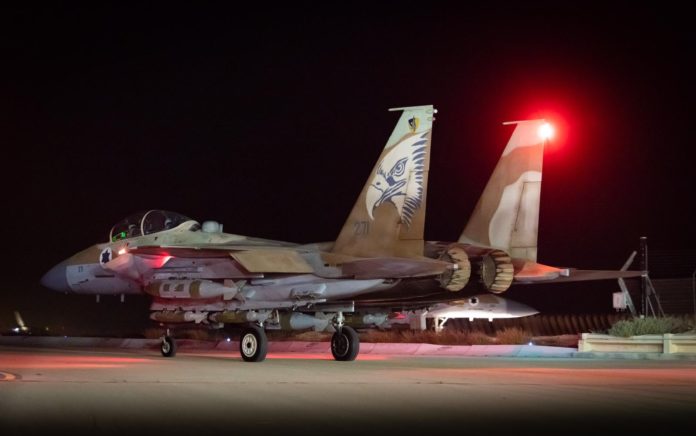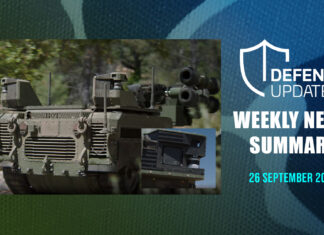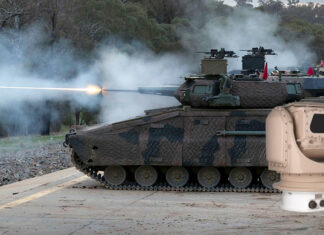
The recent conflict between Israel and the Hamas and Islamic Jihad terror organizations in Gaza brought to light numerous new capabilities developed on both sides. On the Israeli side, Iron Dome Counter Rocket, Artillery, and Mortars (C-RAM) system was a clear winner. In a large-scale deployment of the system throughout the country, Iron Dome units intercepted over 1,500 from 4,360 rockets fired at Israel, demonstrating a 90% success rate. Another new capability was the use of precision heavy guided ground-penetrating bombs to destroy more than 100 km of the subterranean tunnel network Hamas has built under the Gaza strip (the network is estimated to include 500 km of tunnels). Orchestrating the entire operation was the new command and control network recently fielded by the IDF.
The Palestinians challenged the Iron Dome with extensive rocket salvos, some including 50 rockets or more. Up to 140 rockets were fired in 20 minutes. They have markedly extended the range of their rockets and employed new multiple launchers stacking six, nine, and 12 heavy rockets fired at targets 70 – 90 km away. They also introduced heavy Rocket Assisted Munitions (IRAM) loaded with 400 kg of explosives, aimed at cross-border short-range targets.
They tried to reach targets farther than ever before, at ranges up to 200 km, deployed attack drones, and autonomous submersibles (UUV) in an attempt to hit Israel’s offshore platforms. A significant new capability demonstrated in operation ‘Guardian of the Walls’ were attacks against the subterranean network Hamas has built under the populated areas throughout the Gaza strip. The attacking change was a dramatic improvement in efficiency, a process enabling the close collaboration of air, land, sea, space, and cyber operations.
The Targeting Revolution
“We dramatically shortened the time of closing the Sensor-to-Shooter processes, or ‘fire circles’ – the time between the detection and location of a target to the attack of that target.” Brigadier General Yariv Nir, the chief communications and information technology officer in the IDF cyber and cyber defense division told ‘People and Computers’. “This process includes receiving information from a variety of sources, sensors, intelligence, operational and legal elements, the processing and dissemination of that information to different stakeholders and, finally, issuing the orders to attack that target, with the information necessary for precision attack. This process has been shortened by 40% – 30% in recent years.”
According to the new method of work, the army first decides what the concentration of effort is, what are the enemy abilities they want to deny, and then performs the target research to find the most suitable targets. Based on the target database that keeps refreshing all the time, the targeting system automatically taps information from the target pool, uploads insights, and selects the best targets based on specific parameters to formulate a fire plan. This process is very precise, as the accuracy of attack is down to targets located in a specific window or room in a house.
According to the IDF, the Southern Command Fire Center and Air Force headquarters can carry out an attack of thousands of targets per day. During the recent campaign, the IDF launched 1,500 strikes, primarily against the underground network in Gaza, destroyed 15 strike tunnels (directed at the border), struck 340 rocket launchers (including 79 multiple launchers of heavy rockets).
To fill the target database ‘bucket’ the IDF has recently fielded an ICT ‘machine’ that automates the production of targets, from the initial indication phase to the final indictment phase and its signing by three different intelligence agencies. In the past, this task was mainly based on human research work that took days, even weeks, but now it is done in few hours.
Information Dominance
To accelerate the targeting process the IDF employed a digital situation assessment performed with the IDF operational Internet service provided through the combat cloud infrastructure. This capability that was previously reserved only to the General Staff is now extended to the division level, enabling staff officers to share a joint situation picture and conduct situation assessments on tools developed in the Information and Communications Technology (ICT).
This situational picture gathers all activities related to enemy actions, including mortar and rocket launches and impact points, red and blue force locations, and operational plans. The system also provides decision support and automated reporting tools that save time and accelerate decision and action. Decision-making is based on real-time information fusion, tapping all the relevant intelligence with advanced information extracting tools. This process allows cross-reference and information fusion at a very high level. For example, if a certain site was attacked, but the launches continued from it – an alert is received immediately. This capability enables IDF commanders at the operational level to make information-based decisions in real-time.
Although the system proved highly effective, initial lessons learned by the IDF show that the process of detection and localization of rocket launchers still has room for improvement, since the IDF succeeded in destroying only 40 percent of these elusive targets, thus allowing Hamas to continue and launch rockets throughout the conflict.
The core delivering this operational capability is the latest version of Elbit System’s Digital Army Program (TORCH 750), the main C4ISR system of Israel’s Defense Force (IDF), that was recently fielded up to the division level. During the operation, deployed systems were augmented with much more bandwidth to address the exponential demand from users through multi-domain services. The system was previously deployed at the brigade level and below, including the Golani Brigade, the 7th Armored Brigade, the Commando “Oz” Brigade, and the Multi-Domain unit. Shortly before the operation, the system became operational at the division level, as the 162nd and 36th Divisions were preparing for a large-scale exercise planned for the summer.
The previous hierarchical command and control of military domains of ground, underground, sea, sky, and space spheres required specific networks that could not easily exchange information. The new system integrates data from the three IDF branches—ground, air, and naval units—to create a combat network for the multi-domain battlefield. This network enables the modern combat force to communicate in the most efficient way possible and allows the entire combating force, from the division and brigade commander to the soldier in the field, to communicate in the fastest way possible. This operational flexibility enables every user to seamlessly reach other users regardless of the interference, location, or domain.
This interoperability allows all parties in the battle to communicate sharing a common operational language based on standardized communications and security protocols. For example, smart rifle sights allow soldiers in the field to mark a target, which will appear on the screen of a senior commander in the command center. The system calculates which is the right weapon to use, what is the right munition, what is the exact angle needed to attack. Upon selection and confirmation, the system then sends within seconds the target information to a weapon system to perform the attack.
In addition to communications and processing the Digital Army Program system integrates decision support services to help officers processing information and taking decisions rapidly. Officers are presented with available order-of-battle and locations of all combat elements, ammunition availability, and supply levels. The system accesses all sensors that can watch the target, and stores technical data, combat doctrine, safety, and legal restrictions that apply to the use of the different weapons that could engage the target. Based on this data, and much more, the system selects several alternatives and recommends them to the commander for decision.
Multi-Dimensional C4I
The new C4ISR system was a central element in the formation of the IDF’s new “Oz” Commando Brigade and “Ghost” Multidimensional Unit, considered as the blueprint for the future IDF ‘multidimensional’ battalion. This unit has the manpower of a battalion, but the firepower, maneuverability, and terrain dominance of a brigade.
The unit was established as part of the military’s “Tnufa” multi-year plan initiated by IDF Chief of Staff Lt.-Gen. Aviv Kohavi. The multidimensional battalion is prepared to fight on any terrain, including underground, in tunnels; above ground, and near the ground, where the enemy is expected to use drones to reconnaissance and attack. The Oz Commando brigade is part of the IDF deep attack force.
Ghost and Oz Commando Brigade can rely on the advanced communications and networking provided by TORCH 750 to effectively employ small units, empowered by organic intelligence and firepower, and use transport, logistic, and fire support from the ground, air, and sea.



















